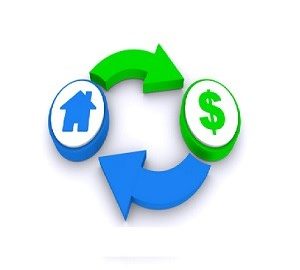Reverse Mortgage
 A reverse mortgage also called a Home Equity Conversion Mortgage (HECM) is a financial technique used by those who own their home free and clear to use the value of the home to create a monthly income, without having to move out of the home or sell it outright. Alternatively, for those with substantial equity value in their home, a reverse mortgage may be used to pay the remaining monthly mortgage payments.
A reverse mortgage also called a Home Equity Conversion Mortgage (HECM) is a financial technique used by those who own their home free and clear to use the value of the home to create a monthly income, without having to move out of the home or sell it outright. Alternatively, for those with substantial equity value in their home, a reverse mortgage may be used to pay the remaining monthly mortgage payments.
The amount of the monthly proceeds from a reverse mortgage depends on the value of the home and the age of the person(s) applying for the reverse mortgage. The minimum age permitted to apply for a reverse mortgage is 62-years old.
The reverse mortgage concept was created to assist retired persons on a fixed income to use the equity in their homes to provide a monthly payment for living expenses and health care. A person taking a reverse mortgage does not have to pay back the loan unless the home is sold. As long as the person lives in their own home, they do not have to make any payments on the loan. The homeowner is responsible for paying the property taxes, home insurance, and any homeowner’s association fees if necessary. A homeowner retains ownership of a home with a reverse mortgage. When the person dies, if there is no surviving spouse, the home can be given to heirs; however, the reverse mortgage loan needs to be repaid.
A reverse mortgage is taking a credit line on the home. The lenders assess the home’s value and check the credit history of the borrower. The borrower can choose a variable rate loan with an interest rate based on the monthly or annual rates for LIBOR plus the lender’s margin or the borrower may choose a fixed rate.
Example of a Reverse Mortgage Calculation
A person who is 62-years old and has $300,000 in equity value in the home wants to have a reverse mortgage to use for an emergency credit line of $50,000 for health care and the balance as monthly income to pay living expenses.
In October 2016, the choices for variable loans are either the 1-month LIBOR rate of 0.529% plus the lender’s margin of 2.5% and mortgage insurance of 1.5% making the initial interest rate equal to 4.279% or the Annual LIBOR rate of 1.587% plus the lender’s margin of 3.0% and mortgage insurance of 1.5% making the initial interest rate equal to 5.996%.
If a fixed rate is chosen instead, the interest rate will remain 6.310% for the life of the loan.
Choosing a variable interest rate during times when interest rates are low is risky because the rate may rise substantially in the future. The lifetime interest rate cap on the 1-month LIBOR rate loan is 13.029% and the Annual LIBOR loan cap is 9.587%.
With $300,000 in value, the maximum amount of the reverse mortgage is $181,800. Closing costs for the loan are $8,907.75, which leaves $172,892 remaining. If $50,000 is held back from this amount to serve as a credit line for health care expenses and then the monthly payments from the remaining $172,892 would be between $700 and $760 depending on whether a variable or fixed rate is chosen.
Summary
A reverse mortgage is a useful financial tool to extract value from a home without having to move out or sell it. Be sure to seek competent legal counsel and financial advice from a trusted financial planner before taking out a reverse mortgage.